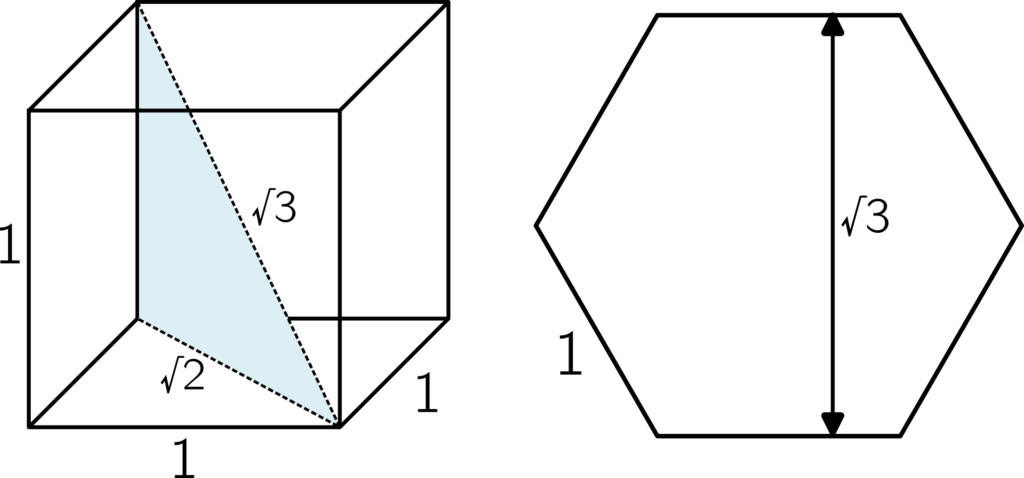A Ubiquitous Surd
BLOG: Heidelberg Laureate Forum

Mathematical discoveries that involve the square root of three are like buses – you wait a long time for one, then two come along at once (to be clear: that is pretty much the only way in which they are alike). In the past few months, I spotted two mathematical papers that had been published which both regard interesting mathematical discoveries, and both involve the square root of 3.
The square root of 3 is an irrational number, approximately equal to 1.732, and we already knew it was a great number. It is the length of the 3D diagonal, from corner to corner, of a cube with side length 1; it is also (not completely unrelatedly) the height of a regular hexagon with sides of length one.

But thanks to some recent new discoveries, the square root of three now has some new facts about it, and I thought both were interesting enough to share with you.
Jump on the Bandwagon
The Möbius Band, a fascinating topological shape which I have mentioned in previous posts here, can be made from a simple strip of paper by putting in a twist and gluing the ends together. As well as having some intriguing properties, this shape is a well-known mathematical object and provides endless amusement for school-children everywhere when they try to cut it in half along its length (also: adults).
And while people have been making Möbius bands from paper for decades, there has been a related underlying mystery, particularly concerning the extremes of this object. What is the shortest strip of paper you can use to make one?
Late last summer, mathematician Richard Schwarz posted a paper on the arXiv which provided an answer to this question, which has remained open for nearly 50 years. It has long been suspected that the shortest possible band is one which is so short, it wraps around itself exactly and forms an equilateral triangle. But nobody had been able to prove that this was the minimum length possible – until now.
The proof involves considering the Möbius band as an object called a fibre bundle – imagine a circle that runs around the length of the band (namely, the line you cut it along if you want to impress someone). At each point around this circle, you could imagine a thin vertical strip of paper attached to the circle at that point, that lies inside the Möbius band.
Mathematicians attempting to describe a fibre bundle often use the analogy of a comb: a straight stick lying horizontally, at every point of which is attached a single vertical tooth. The Möbius band instead has the spine running around its middle and the ‘teeth’ extend the same distance above and below at each point. And as you pass around the band, these teeth change direction, but at every point they are smoothly joined to the ones on either side.
Part of the reason the Möbius band is so interesting is because it shares this property with the boring, untwisted cylinder – looking at any one small section of the strip, they are identical – but the overall twist in the band means it behaves very differently.
Schwarz realised – through a process of computer simulations, combined with playing with actual physical paper Möbius bands – that there was a way to use this structure to prove the limit of the square root of three was indeed optimal, and he describes it in the paper.
He has also produced this ‘friendly account’, a more accessible version of the paper designed for a general audience (and I am a big fan of mathematicians who produce these kinds of accompanying papers with their research!). There are also a few more in-depth articles about the result, including one in Scientific American by Rachel Crowell and this Quanta article which also covers minimal multi-twist Möbius bands as well as trefoil knots.
If you would like to make your own Minimal Möbius Monstrosity, you will need a strip of paper which is √3 (around 1.73) times as long as it is wide, and to fold it into two equilateral triangles and two half-triangles, fold it over and add a bit of tape, as shown.
Picking up the Pieces
Meanwhile, as if the square root of three hadn’t had enough attention already, we saw it again in a paper posted on the ArXiV last December and plainly titled “How big a table do you need for your jigsaw puzzle?”. Madeleine and Kent Bonsma-Fisher, a data scientist and quantum physicist from Canada, have calculated the relative area of a table taken up by a solved and unsolved jigsaw puzzle.
Modelling each piece as approximately a circle with the same diameter as the widest part, since the tabs sticking out will prevent them from packing as closely, they have estimated that the ratio of areas is roughly our good friend √3.
This is obviously only an estimate, but it is based on the principle that optimal circle packing in the plane forms a hexagonal grid – and the result involves the fact that the height of a hexagon is √3 times its side length. It is also independent of how many pieces the jigsaw has!
This should allow anyone unpacking a jigsaw – which might have the dimensions of the completed puzzle stated on the box – to calculate how much table space they will need, and make sure there is enough room. You can read more in this New Scientist article, which includes some quotes from the researchers.
It is no surprise that mathematical constants turn up in more than one place – just think about the number of places a constant like π or e seem to pop up – but the fact that these two new pieces of research turned out to hinge on the same value, and were discovered only a few months apart, made me smile.


